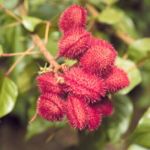| Common Name: |
Achiote |
| Other Names: |
Annatto, roucou, lipstick tree |
| Botanical Name: |
Bixa orellana |
| Genus: |
Bixa |
| Family: |
Bixaceae |
| Cultivation: |
Well-drained, moist soil and high humidity. Prune hard if grown as a hedge. Trim specimen plants as required. |
| Propagation: |
By seed sown as soon as ripe in sand, at 19-24°C (66-75°F); by semi-ripe cuttings at 30°C (86°F). Seed-raised plants are slow to reach flowering size. Plants from cuttings flower when small. |
| Harvest: |
Leaves are picked as required and dried for use in infusions. Seeds are collected as the fruits split open and are soaked in hot oil or lard, crushed in water, fermented, and made into cakes or ground up, depending on region and intended use. |
| Native Region: |
Tropical America, West Indies |
| Height: |
7m (22ft) |
| Width: |
3-4m (10-12ft) |
| Hardiness: |
Min. 16°C (61°F) |
| Parts Used: |
Leaves, fruits, seeds |
| Properties: |
A bitter, astringent, purgative herb that reputively destroys intestinal worms, lowers fevers, improved digestion, and has expectorant effects. |
| Medicinal Uses: |
Internally for mouth cancer (seed pulp, in Mexico), worms in children, dysentery, colic, and fevers (leaves in the West Indies); fevers especially in children and after childbirth (infusions of leaves, in Indo-China). Externally on burns to prevent blistering and scarring (ground seeds, in the Phillipines). |
| Culinary Uses: |
Seeds are used to color and flavor rice, soups, chocolate, and dishes based on eggs, meat, fish, or vegetables. |
| Economic Uses: |
Fruit pulp yields colorant, used in foods (especially margarine, cheese, soups, and smoked fish), in the cosmetic industry, and also to dye maggots for fish bait. |
| Bibliography: |
Encyclopedia of Herbs by Deni Brown Copyright © 1995, 2001 Dorling Kindersley Limited. pg 144.
|

